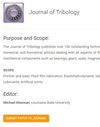小数据集机器学习用于激光粉末床熔合钢磨损预测
IF 3
3区 工程技术
Q2 ENGINEERING, MECHANICAL
引用次数: 0
摘要
增材制造零件的磨损性能是保证增材制造零件功能和可靠性的关键。然而,由于制造过程和接触条件的众多影响因素,磨损预测是艰巨的。如果有足够的数据集,机器学习提供了一个简单的方法来预测机械性能,如果没有足够的数据集,要达到高的预测精度是非常具有挑战性的。在这项工作中,使用改进的机器学习算法和数据增强相结合,仅基于54个数据就实现了激光粉末床熔化和原位表面改性制造的316L不锈钢零件的高精度磨损预测。为了增强数据,提出了一种新的修正温度比。对四种常见的机器学习算法和麻雀搜索算法优化的反向传播神经网络进行了比较。结果表明,经过数据增强后,所有算法的预测精度都有所提高,其中改进的机器学习算法的预测精度最高(R2=0.978)。这种方法适用于预测使用其他增材制造技术制造的零件的其他系统复杂性能。本文章由计算机程序翻译,如有差异,请以英文原文为准。
Small-dataset machine learning for wear prediction of laser powder bed fusion fabricated steel
The wear performance of an additively manufactured part is crucial to ensure the component's functionality and reliability. Nevertheless, wear prediction is arduous due to numerous influential factors in both the manufacturing procedure and contact conditions. Machine learning offers a facile path to predict mechanical properties if sufficient datasets is available, without which it is very challenging to attain a high prediction accuracy. In this work, high-accuracy wear prediction of 316L stainless steel parts fabricated using laser powder bed fusion and in-situ surface modification is achieved based on only 54 data using a combination of an improved machine learning algorithm and data augmentation. A new modification temperature ratio was introduced for data augmentation. Four common machine learning algorithms and sparrow search algorithm optimized back propagation neural network was conducted and compared. The results indicated that the prediction accuracy of all algorithms was improved after data augmentation, while the improved machine learning algorithm achieved the highest prediction accuracy (R2=0.978). Such an approach is applicable to predict other systematically complex properties of parts fabricated using other additive manufacturing technology.
求助全文
通过发布文献求助,成功后即可免费获取论文全文。
去求助
来源期刊
CiteScore
4.20
自引率
12.00%
发文量
117
审稿时长
4.1 months
期刊介绍:
The Journal of Tribology publishes over 100 outstanding technical articles of permanent interest to the tribology community annually and attracts articles by tribologists from around the world. The journal features a mix of experimental, numerical, and theoretical articles dealing with all aspects of the field. In addition to being of interest to engineers and other scientists doing research in the field, the Journal is also of great importance to engineers who design or use mechanical components such as bearings, gears, seals, magnetic recording heads and disks, or prosthetic joints, or who are involved with manufacturing processes.
Scope: Friction and wear; Fluid film lubrication; Elastohydrodynamic lubrication; Surface properties and characterization; Contact mechanics; Magnetic recordings; Tribological systems; Seals; Bearing design and technology; Gears; Metalworking; Lubricants; Artificial joints

 求助内容:
求助内容: 应助结果提醒方式:
应助结果提醒方式:


